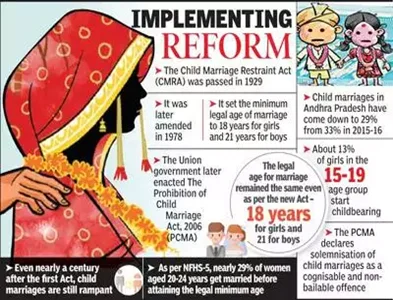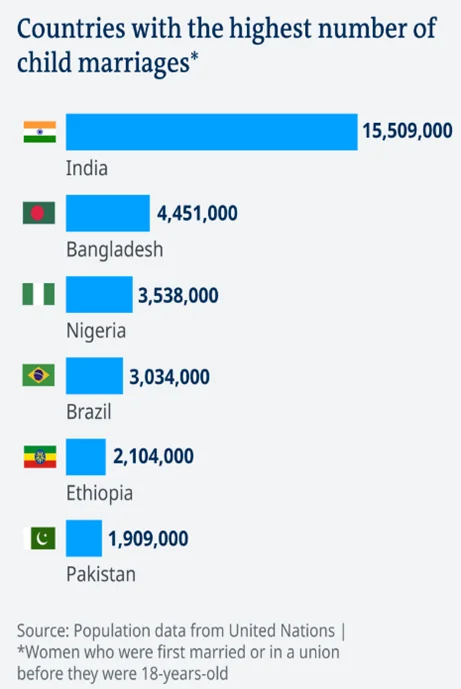Social Issues
Context: Activists working on ground suggest that the COVID-19 pandemic combined with poverty may have worsened the phenomenon of child marriage in India.
About Child marriage:
- Child marriage can be described as a formal marriage or an informal union entered into by an individual before attaining the prescribed eligible age.
- The legally prescribed marriageable age in some jurisdictions is below 18 years, including India.
Child marriage in India:


- Child marriage prevalence is generally defined as the percentage of women 20-24 years old who were married or in union before age 18.
- India is estimated to have over 24 million child brides.
- According to the National Family Health Survey, 40% of the world’s 60 million child marriages take place in India.
- According to the International Centre for Research on Women, India has the 14th highest rate of child marriage in the world,
- Eight States have a higher prevalence of child marriage than the national average —
- West Bengal, Bihar and Tripura top the list with more than 40% of women aged 20-24 years married below 18, according to NFHS data.
- In Kerala, women who got married before the age of 18 stood at 6.3% in 2019-20, from 7.6% in 2015-16.
Reasons for child marriage in India:

- Customs and Traditions: Traditions like dowry put a lot of stress on the family because the parents have to give a lot of money, jewellery, land etc. for their daughter to get married.
- Generally the amount of dowry rises with age of the girl, so families prefer to marry their girls young.
- Poverty: Poor Families ‘sell’ their children through marriage to pay off debts or to get out of the cycle of poverty.
- Child marriage makes families poorer because young girls who get married won’t be educated or skilled enough to do well in the workforce.
- “Protecting” the Girl’s Sexuality: In some cultures, marrying a girl young is thought to “protect” the girl’s sexuality and the family’s honour.
- Security: Parents often marry their daughters off young to “secure” a good future for them.
- Abuse, rape, and other crimes against girls, as well as extreme poverty, can make parents turn to child marriage as a way to protect their daughters.
- Laxity in Implementation of Laws: Laws are not implemented stringently. In many cases the ages of the bride and groom aren’t checked at the time of registration of marriage.
- Many child marriages aren’t even registered.
- Discrimination based on gender: Child marriage is a manifestation of discrimination against girls and women.
- According to a UNICEF report on ‘Child Marriage and the Law’, “The discrimination often manifests itself in the form of domestic violence, marital rape, and deprivation of food, lack of access to information, education, healthcare, and general impediments to mobility”.
Harmful impacts of Child Marriage:
Child Rights Issues:
- Children who are forced to get married young lose their rights including the right to an education, the right to be safe from physical and mental violence, injury, or abuse, among others.
Health Issues:
- According to NFHS-5, prevalence of child stunting is 35.5% in 2019-21.
- Premature Pregnancy: Most young brides don’t know much about contraception and don’t have easy access to reproductive health services.
- They get pregnant at a younger age and have more than one child before their mind and bodies are ready.
- Maternal Mortality: Girls under 15 are five times more likely to die during childbirth or pregnancy. The leading cause of death for girls ages 15 to 19 around the world is pregnancy-related deaths.
- Infant Mortality: Babies born to mothers younger than 20 have almost 75% higher death rates than babies born to mothers older than 20 years. The children who do make it are more likely to be born pre-mature and with a low birth weight.
Illiteracy:
- Child brides are often taken out of school and not allowed to get further education.
- Research shows that child marriage and pregnancy are the biggest factors that keep girls from going to school.
Intergenerational Cycle of Poverty:
- Child marriage negatively affects the economy and can lead to an intergenerational cycle of poverty.
- Girls and boys married as children more likely lack the skills, knowledge and job prospects needed to lift their families out of poverty.
- Early marriage leads girls to have children earlier and more children over their lifetime, increasing economic burden on the household.
Teen Widows:
- In a society that allows child marriages, it is not unusual to find widows and divorcees under the age of 18.
Laws and Policies to prevent child marriages:
- The Child Marriage Restraint Act of 1929: It is also known as the Sarda Act. It was a law enacted to restrain the practices of Child Marriage.
- Its main goal was to eliminate the evils placed on young girls who could not handle the stress of married life and to avoid early deaths.
- This act defined a male child as 21 years or younger and a female child as 18 years or younger.
- The Prohibition of Child Marriage Act of 2006: Under this act, the marriageable age for a male is prescribed as 21 years and that of a female is 18 years.
- Child Marriage is prohibited in India as per the Prohibition of Child Marriage Act, 2006.
- Hindu Marriage Act, 1956: Under Hindu Marriage Act, there are no certain provisions for punishing the parents or people who solemnized the marriage.
- A girl can get the marriage annulled only if she wants to get married before attaining the age of fifteen years and she challenges the marriage before turning eighteen.
- Muslim Personal Law: Under the Muslim Laws, there is no bar to child marriage. The couple after marriage has an “option of puberty” known as Khayar-ul-bulugh in which they can repudiate the marriage after attaining the age of puberty.
- The Protection of Children from Sexual Offences Act, 2012: which aim at protecting children from violation of human and other rights.
- A parliamentary standing committee is weighing the pros and cons of raising the age of marriage for women to 21, which has been cleared by the Union Cabinet.
Way forward:
- The solution lies in empowering girls, creating proper public infrastructure and addressing societal norms.
- It should be ensured that Child Protection Committees and Child Marriage Prohibition officers are doing the job and community support groups should be activated.
- Such efforts can lead to Child Marriage Free Villages like in Odisha which now has over 12,000 such villages.
- Local gram panchayat members should be oriented to spread awareness on child marriage, not only that it is illegal to get a child married off before 18, but also the dangers to the child’s health and her offspring.
- There has been a rise in child marriages during the pandemic, but many have been prevented as well.
Source: The Hindu











